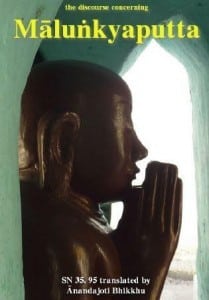
The Discourse concerning Malunkyaputta is from the Connected Discourse Collection (Samyutta Nikaya) of the Pali Canon and it is one the few that deals directly with meditation practice. It describes how the Buddha leads the monk Malunkyaputta through a series of questions and answers meant to bring him to a more complete understanding of reality. The instructions begins:
In what is seen there must be only what is seen, in what is heard there must be only what is heard, in what is sensed there must be only what is sensed, in what is cognized there must be only what is cognized.
The Discourse concerning MalunkyaputtaA translation of one of the few parts of the Pali Canon that deals directly with meditation practice.Written by: Translated by Anandajoti BhikkhuPublished by: Anandajoti BhikkhuEdition: FirstISBN: NoneAvailable in: Ebook
Download the free ebook here (13 pages/200 KB):
 The Discourse concerning Malunkyaputta
The Discourse concerning Malunkyaputta
What is Malunkyaputta?
Malunkyaputta, also known as Māra’s sniper or Māra’s archer, is a character from Buddhist mythology. He appears in a story found in the Pāli Canon, the collection of scriptures in Theravada Buddhism. The story is known as the “Malunkyaputta Sutta” and is part of the Majjhima Nikaya, one of the five collections of the Buddha’s discourses. In the Malunkyaputta Sutta, Malunkyaputta was a monk who approached the Buddha with a series of metaphysical questions and doubts. He was troubled by various speculative and unanswered questions regarding the nature of the universe, existence, and the afterlife. Malunkyaputta expressed his frustration and stated that if the Buddha did not provide satisfactory answers to his questions, he would give up the monastic life.
Prioritize the practice of the teachings
In response, the Buddha compared Malunkyaputta to a man who had been shot by a poisoned arrow and was in urgent need of medical attention. The Buddha explained that it would be foolish for the man to demand answers to irrelevant questions about the arrow, such as who shot it, the caste of the shooter, or the type of wood used for the arrow. Instead, the man should focus on removing the arrow and healing his wounds. Likewise, the Buddha advised Malunkyaputta to set aside his speculative questions and concentrate on the practice that leads to liberation from suffering. The Buddha explained that his teachings were intended to end suffering and lead to liberation, rather than provide answers to metaphysical questions that do not contribute to the path of liberation. The story of Malunkyaputta serves as a reminder to Buddhist practitioners to prioritize the practice of the teachings and the attainment of enlightenment over indulging in unnecessary metaphysical speculations. It highlights the importance of focusing on the practical aspects of the spiritual path rather than getting caught up in theoretical or speculative inquiries.

